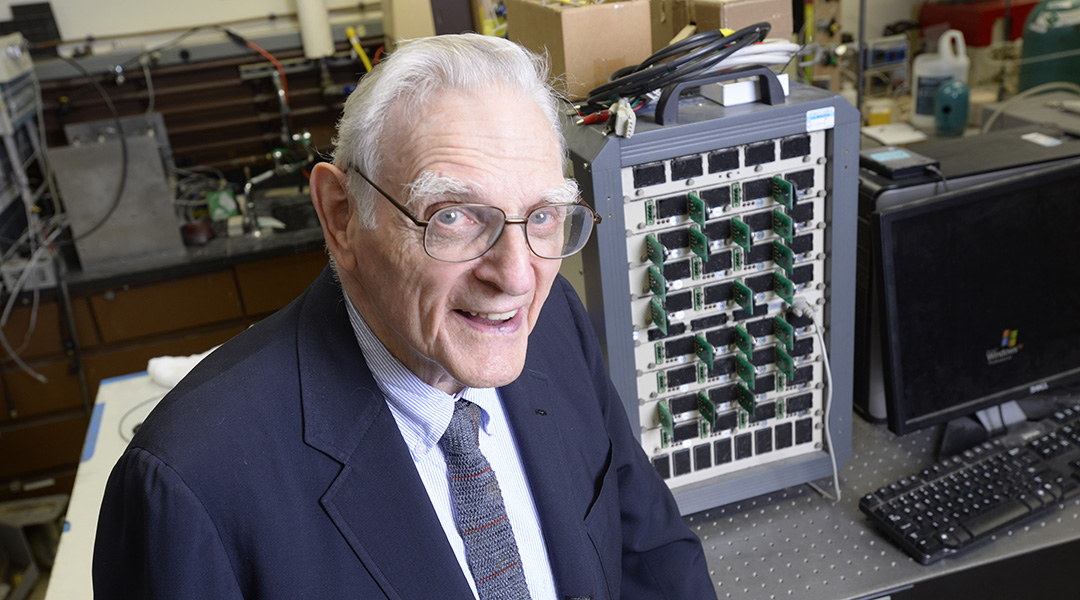Renowned scientist and Nobel Laureate, John B. Goodenough, passed away on Sunday, June 25, at the remarkable age of 100. His legacy as a pioneering figure in the field of science is etched in history, primarily due to his groundbreaking contributions to the development of the lithium-ion battery.
Goodenough’s visionary efforts have played an instrumental role in revolutionizing the way we generate, store, and utilize energy, opening up new frontiers. “John’s legacy as a brilliant scientist is immeasurable — his discoveries improved the lives of billions of people around the world,” said UT Austin President Jay Hartzell. “He was a leader at the cutting edge of scientific research throughout the many decades of his career, and he never ceased searching for innovative energy-storage solutions.”
Born in Germany in 1922, Goodenough grew up in New Haven, Connecticut, and embarked on his illustrious scientific journey in 1944, when he successfully completing his undergraduate studies in mathematics at Yale University. After serving as a meteorologist in the U.S. Army during WWII, he returned to the US to complete graduate studies in physics under solid-state physicist Clarence Zener at the University of Chicago in 1952.
His doctoral work investigated the intricate changes that occur within metal alloys when subjected to the flow of electric current. This area of study helped develop an understanding around the behavior of materials under such conditions, which was crucial for the advancement of numerous technological applications.
This foundation marked the beginning of a remarkable career that would span decades and leave an indelible impact on the world of science.
Following graduation, Goodenough moved to the Lincoln Laboratory at the Massachusetts Institute of Technology (MIT), where he remained for two decades and laid the groundwork for the development of random-access memory (RAM) for the digital computer. His work began with the exploration of the magnetic properties exhibited by transition metal oxides. This period of his career proved to be particularly fruitful, as his seminal research culminated in the formulation of what is now widely known as the Goodenough-Kanamori rules.
The publication of his influential paper in 1955, stands as a testament to the impact of his work, with the Goodenough-Kanamori rules since becoming a cornerstone of understanding and predicting the magnetic behavior of transition metal oxides, shaping the trajectory of research in this field and fostering numerous advancements in materials science and technology.
Following his tenure at MIT, Goodenough became a professor and the head of the Inorganic Chemistry Laboratory at the University of Oxford. It was during this period that he explored the immense potential of lithium-ion technology, unveiling a new era of efficient and rechargeable energy storage. His groundbreaking findings provided a solid foundation for the development and widespread adoption of lithium-ion batteries, which have become an integral component of countless electronic devices and have transformed the way we power our modern world.
In addition to being honored with the prestigious Nobel Prize, which he shared with Stanley Whittingham of the State University of New York at Binghamton and Akira Yoshino of Meijo University, Goodenough amassed a plethora of accolades throughout his illustrious career. His remarkable contributions were recognized through esteemed awards such as the National Medal of Science, the Japan Prize, the Charles Stark Draper Prize, the Benjamin Franklin Medal, the Enrico Fermi Award, the Robert A. Welch Award, and the Copley Medal, among numerous others. Goodenough’s literary accomplishments extended beyond his scientific endeavors, as he also authored several books, including his captivating autobiography titled “Witness to Grace,” which was published in 2008.
Goodenough’s contributions stand as a testament to his exceptional scientific intuition and enduring contributions to the field of energy storage. He leaves behind an amazing legacy.
“I think that everybody needs to find meaning in life. I was hoping to do something that serves the needs of society.”
Feature image credit: The University of Texas at Austin
Read more about his life and career in “Pioneers in Science: John B. Goodenough“

















